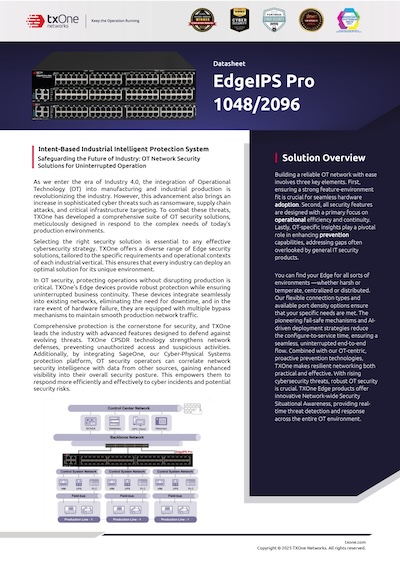Closing the Gap Between Legacy Systems and Modern Cyber Threats
Rail systems are built to keep moving safely, predictably, and without interruption. That’s exactly what makes them so vulnerable. The Operational Technology (OT) environments found in rail systems were designed for service continuity and physical safety, not for the kinds of sophisticated cyber threats they currently face.
As legacy systems become digitally connected through signaling platforms, ticketing services, and remote maintenance software, rail becomes increasingly exposed to risks it was never designed to handle.
Rail operators often assume their biggest risks are already managed. Remote access runs through VPNs, and embedded devices seem isolated and stable. But, in reality, these are precisely the weak points attackers can exploit. Without a shift in mindset, the sector risks being caught off guard by the threats it mistakenly believes are under control.
Why Rail is an Attractive Target
Rail systems have unique cyber vulnerabilities due to their need for high availability throughout long daily operating hours. Unlike some other OT systems, train systems often can’t be taken offline, even briefly. Many rely on legacy SCADA platforms, proprietary signaling systems, and unpatchable infrastructure. This makes the rail environment unusually ill-suited to conventional cybersecurity fixes like patching, segmentation, or routine software updates that require downtime or taking the system offline.
Rail operators also depend heavily on third-party vendors for systems such as onboard Wi-Fi, ticketing kiosks, digital signage, and user apps. Each of these adds a potential access point for attackers.
These vulnerabilities don’t go unnoticed by threat actors. According to TXOne Networks’ 2024 transportation cybersecurity report, the transportation sector was the #2 most-targeted sector in Europe from 2023 to 2024, second only to public administration systems.
Cybercriminals know that rail operators’ first priority is to keep trains moving, and there is no margin for downtime. That makes rail systems high-leverage targets for ransomware, disruption campaigns, or geopolitical attacks.
Rail Cyberattacks
Railways have experienced multiple high-profile cyberattacks in recent years.
- Ukraine Rail (2025): Amid wartime disruptions, a cyberattack caused significant delays to ticketing and signal systems on Ukraine’s state-owned railway Ukrzaliznytsia, the country’s largest rail carrier. With air travel grounded due to the war, the train system became the primary way for civilians and freight to travel throughout the country.
- Transport for London (2024): A data breach originating in back-office systems disrupted rider-facing services, delayed accessibility rollouts, and exposed the personal data of thousands of customers and employees.
- DSB, Denmark (2022): A ransomware attack on third-party vendor Supeo forced Denmark’s largest rail operator to halt all passenger trains nationwide after a critical driver app became unavailable. The disruption, caused by a supply chain breach, marked the first completely cyber-triggered shutdown of rail service in the country.
This is just a small sampling of attacks. Even when an attack didn’t bring trains to a full stop, they all caused real-world operational disruption, major inconvenience, erosion of public trust, and required significant recovery efforts.
False Confidence May Be the Biggest Threat
One of the most dangerous threats to rail cybersecurity is internal complacency. OT systems in rail are often assumed to be reliable, robust, and safely separated from internet-connected infrastructure. In some cases, they’re assumed to be air-gapped from IT systems and therefore immune to the types of attacks that plague IT systems. That assumption is increasingly incorrect.
In TXOne Networks’ annual OT security report, 95% of organizations reported confidence in their OT cybersecurity posture. Yet 67% of those same organizations experienced a cyber incident in the past year. Many of the systems being protected and assumed safe are not sufficiently monitored, regularly patched, or actively managed.
Meanwhile, threat actors are getting smarter, faster, and stealthier, often gaining a foothold in systems, and quietly taking up residence for weeks or months before launching an attack. These long dwell times allow them to study the environment, escalate privileges, and strike when the impact will be greatest.
Rail OT Threats
Some of rail’s most common cybersecurity gaps are structural, not technical:
- Flat networks with no segmentation between IT, OT, and third-party environments leave systems wide open to lateral movement, allowing attackers to pivot from a compromised workstation to critical control systems with little resistance.
- Shared credentials across systems and users create a single point of failure. Once an attacker compromises one login, they may gain access to multiple systems across the environment.
- Remote access tools are often used without strong authentication or role-based access controls, making them an easy entry point for attackers who exploit weak passwords or improperly secured external connections.
- Unmonitored endpoints, including those managed by vendors or installed in hard-to-reach locations, often operate without visibility or control, making them ideal hiding spots for attackers to remain undetected.
These vulnerabilities are compounded by the difficulty of staying current with required patching in many rail systems. In some cases, applying patches would require re-certifying safety systems or halting operations, both unacceptable costs for many rail operators.
What Rail Can Do Right Now
Despite these constraints, there are practical, rail-adapted cybersecurity defenses that make a real difference.
| Challenge | Defense Strategy |
| Unpatchable legacy systems | Lock down endpoints with allowlisting (TXOne Stellar) |
| Flat, unsegmented networks | Monitor and segment networks with OT-native network security appliances (EdgeIPS) |
| Third-party inputs, USB exposure | Scan and inspect all media before entering OT environments (TXOne Element) |
| No visibility into OT assets | Use passive discovery and asset mapping to monitor and track system vulnerabilities and risks |
| Lack of OT-specific incident plans | Include engineers and vendors in tabletop drills and playbooks |
Even systems that can’t be patched can still be monitored, locked down, and segmented to contain threats. The key isn’t bringing IT-style security into OT. It’s deploying OT-native tools that respect the operational constraints of rail systems.
Keep the Trains Moving and Protected
Rail systems cybersecurity needs an honest reassessment. Rail systems can still be secure, but only if cybersecurity is approached with the same clarity and practicality that’s long defined physical safety.
Cybersecurity in rail isn’t just about preventing disruption — it’s about protecting continuity, safety, and trust in a system that can’t afford to fail. Traditional IT security tools often fall short in OT environments where uptime is critical, and systems can’t be patched or replaced without major operational impact. What rail needs is a defense strategy that works within those constraints.
TXOne’s security tools are designed to keep railways safe. Stellar locks down unpatchable endpoints, EdgeIPS segments networks to contain threats, and Element protects against malware from portable media. Together, they offer a multi-layered approach that fits the operational demands of always-on rail systems.





